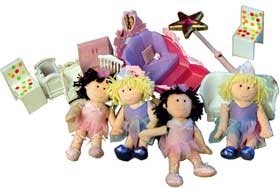PlayPals are wireless figurines with their electronic accessories that allow children aged 5-8 to communicate between remote locations.
When a child at one location moves one doll’s hands, the remote synchronized doll moves its hands in the same way. The dolls alone communicate only by gestures. Each child has a set of tokens that are used as the dolls’ accessories. When a token is placed in a doll’s hands, it functions as a different communicating tool: adding a “walkie-talkie� token to the doll, enables synchronous voice communication, a microphone for asynchronous is used for voice communication, a video camera for synchronous audio-visual communication, a digital camera for asynchronous visual communication, etc.

To make a recording, the child places an accessory (camera, microphone, screen) in the doll’s hand. To share the recording, children need another doll that represents their friend. They can put the recording tool in the friend’s hand to share the video or audio, or they can place the tool near a computer where the data can be saved. To display an image or video, a computer can be used or else a small screen placed near the doll or in its hand.
A pilot study showed that embedding digital communication into existing play pattern enhances both remote play and communication.
By Leonardo Bonanni, Jeff Lieberman, Cati Vaucelle and Orit Zuckerman.
Movie.
Related projects on Pasta & Vinegar: Plush-based remote control, teddy bear-based robotic user interface.
More dolls: Fat, evidence dolls, myBio dolls, voodoo doll-controlled game, Needies, sex doll with cold feet and heartbeats, robot dolls addicted to drugs.
